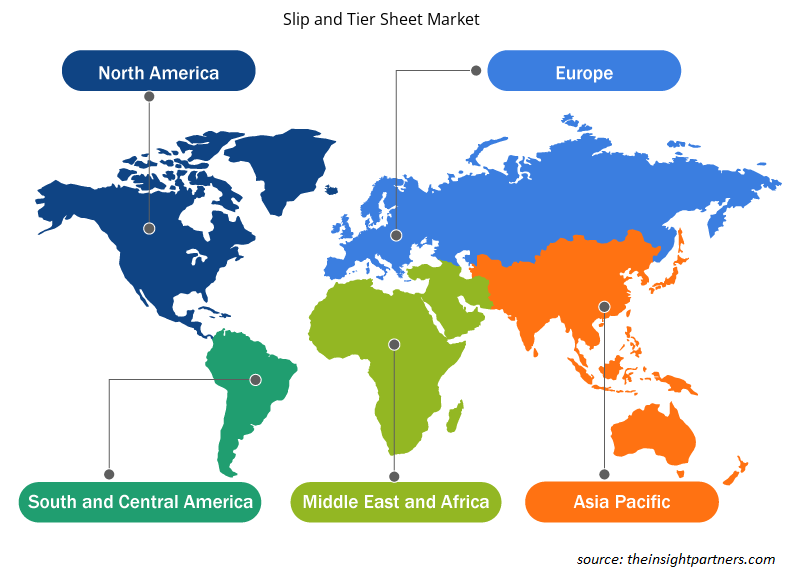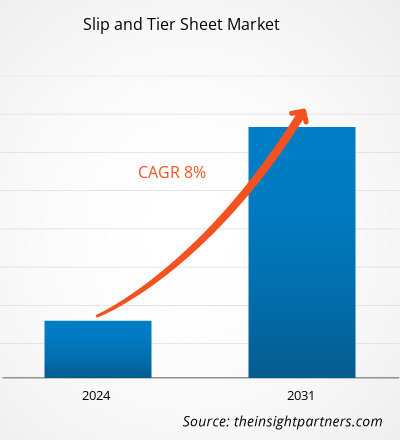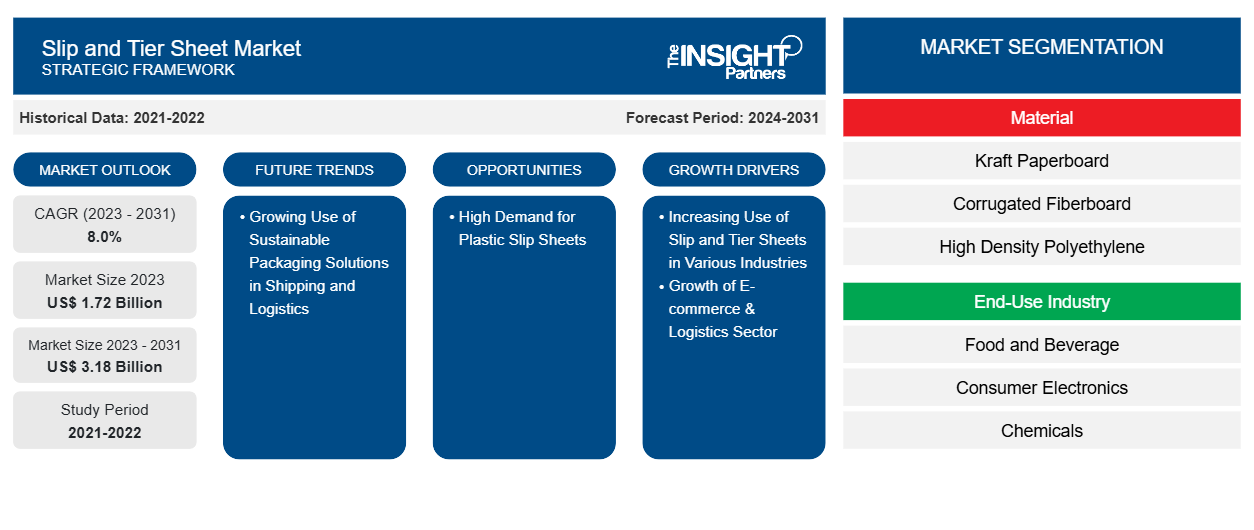Der Markt für Trenn- und Zwischenblätter soll von 1,72 Milliarden US-Dollar im Jahr 2023 auf 3,18 Milliarden US-Dollar im Jahr 2031 wachsen; für den Zeitraum von 2023 bis 2031 wird eine durchschnittliche jährliche Wachstumsrate (CAGR) von 8,0 % erwartet.
Markteinblicke und Analystenansichten:
Slip- und Zwischenlagen sind kostengünstige Alternativen zu Holzpaletten. Diese Lagen nehmen weniger Platz ein als Holzpaletten und ermöglichen den Transport größerer LKW-Ladungen, was den Unternehmen Logistikkosten spart. Slip- und Zwischenlagen werden im Allgemeinen aus Kraftpapier, Wellpappe, Polyethylen hoher Dichte und Polypropylen hergestellt. Hersteller entwerfen Slip- und Zwischenlagen basierend auf der Anzahl der Lippenverlängerungen, die mit der Ladevorrichtung verbunden werden. Die zwei grundlegenden Arten von Slip- und Zwischenlagen sind einlippig und mehrlippig. Die Slip- und Zwischenlage aus Wellpappe besteht aus zwei Lineroberflächen mit einer gewellten Innenseite, die mit Klebstoff oder Leim verbunden ist. Slip- und Zwischenlagen aus Karton haben ein hohes Grundgewicht und eine hohe Dichte. Sie werden in mehreren miteinander laminierten Schichten hergestellt, und diese Verbindung ermöglicht die mehrfache Verwendung der Lagen in Umgebungen mit unterschiedlichen Temperaturen. Kunststoff-Slip- und Zwischenlagen werden aus thermoplastischen oder duroplastischen Polymeren hergestellt. Kunststoff-Slip- und Zwischenlagen werden immer beliebter, da sie kostengünstig sind, eine hohe Festigkeit aufweisen, für die Handhabung schwerer Materialien geeignet sind und den Produkten eine starke strukturelle Unterstützung bieten. Unternehmen bieten Slip- und Zwischenlagen mit festgelegten Abmessungen in Länge, Breite und Dicke an. Zwischenlagen sind in verschiedenen Größen erhältlich. Darüber hinaus bieten die auf dem Markt tätigen Unternehmen Einlege- und Zwischenblätter in jeder beliebigen Größe an.
Wachstumstreiber und Herausforderungen:
Die zunehmende Verwendung von Slip- und Zwischenlagen in verschiedenen Branchen trägt zum wachsenden Markt für Slip- und Zwischenlagen bei . Slip-Sheets sind eine dünne und leichte Alternative zu Holzpaletten. Slip-Sheets sind viel leichter als Paletten; ihre Verwendung für Transport oder Lagerung ist viel einfacher. Im Vergleich zu herkömmlichen Paletten sparen sie mehr Platz, sodass Benutzer mehr Produkte exportieren können. Daher tragen der reduzierte Lagerraum und das leichte Design von Slip-Sheets zur Senkung der Transportkosten bei. Slip-Sheets tragen auch zur Reduzierung der Kraftstoffemissionen bei, da sie leichter zu transportieren sind als Holzpaletten. Sie sind leicht recycelbar, umweltfreundlich, vielseitig und können in kalten und feuchten Umgebungen verwendet werden. Holzpaletten bergen ein hohes Risiko für Nagetierbefall und Kontamination. Aufgrund der Dünnheit der Slip-Sheets können Nagetiere den Bereich darunter jedoch nicht besetzen, was zu einem saubereren Lager führt. Benutzer können die Slip-Sheets einfach entsorgen und die Ansammlung von Verunreinigungen im Laufe der Zeit vermeiden. Darüber hinaus werden Slip-Sheets immer beliebter, da Unternehmen ihr Potenzial für eine Kapitalrendite erkennen. Daher führen die Vorteile der Verwendung von Slip-Sheets gegenüber Paletten zu einer erhöhten Produktnachfrage in verschiedenen Endverbrauchsbranchen. Darüber hinaus werden Zwischenlagen aus 100 % Recyclingpapier hergestellt . Diese Lagen sind in verschiedenen Größen erhältlich, die mit allen Palettenarten kompatibel sind. Zwischenlagen sind langlebig und können auch unter rauen Bedingungen verwendet werden. Aufgrund der Vorteile von Zwischenlagen werden diese Lagen zunehmend für die Verpackung von Getränkeflaschen, Dosen, Behältern, Konsumgütern, Industriegütern und -teilen, verarbeiteten Lebensmitteln, Milchprodukten und Trockenwaren wie Salz, Getreide und Zutaten verwendet. Zu den Markttrends für Zwischenlagen und Zwischenlagen gehört die zunehmende Verwendung nachhaltiger Verpackungslösungen in Versand und Logistik.
Die Verwendung von Slipsheets bringt einige Nachteile mit sich. Kunden müssen verschiedene Geräte kaufen oder mieten, um Slipsheets zu handhaben, da Standard-Gabelstapler nicht funktionieren. Wenn Slipsheets als direkter Ersatz für Paletten verwendet werden, ist ein Push-/Pull-Aufsatz für den Gabelstapler erforderlich, der teuer ist. Außerdem erfordert die sichere Handhabung solcher Aufsätze Fachwissen und entsprechende Schulung. Darüber hinaus sind Slipsheets bis zu einem gewissen Grad nicht in der Lage, schwere Produkte zu tragen. Die strukturelle Unterstützung, die Slipsheets bieten, ist geringer als die von Paletten, und sie tragen nicht so viel Gewicht wie Paletten. Daher sind sie keine geeignete Option für Unternehmen, die schwere Produkte versenden. Darüber hinaus werden Wellpapp-Slipsheets geschwächt, wenn sie mit Wasser und Feuchtigkeit in Kontakt kommen, und sind daher für gekühlte Lieferketten ungeeignet. Diese mit der Verwendung von Slipsheets verbundenen Nachteile bremsen das Wachstum des globalen Marktes für Slip- und Zwischenlagen.
Passen Sie diesen Bericht Ihren Anforderungen an
Sie erhalten kostenlos individuelle Anpassungen an jedem Bericht, einschließlich Teilen dieses Berichts oder einer Analyse auf Länderebene, eines Excel-Datenpakets sowie tolle Angebote und Rabatte für Start-ups und Universitäten.
-
Holen Sie sich die wichtigsten Markttrends aus diesem Bericht.Dieses KOSTENLOSE Beispiel umfasst eine Datenanalyse von Markttrends bis hin zu Schätzungen und Prognosen.
Berichtssegmentierung und -umfang:
Die „Globale Marktanalyse für Slip- und Tier-Sheets“ wurde unter Berücksichtigung der folgenden Segmente durchgeführt: Material, Endverbrauchsbranche und Geografie. Basierend auf dem Material ist der Markt in Kraftkarton, Wellpappe, Polyethylen hoher Dichte und andere segmentiert. Nach Endverbrauchsbranche ist der Markt in Lebensmittel und Getränke, Unterhaltungselektronik , Chemikalien, Pharmazeutika, Einzelhandel und andere segmentiert. Der geografische Umfang des Berichts zum Slip- und Tier-Sheet-Markt konzentriert sich auf Nordamerika (USA, Kanada und Mexiko), Europa (Deutschland, Frankreich, Italien, Großbritannien, Russland und der Rest von Europa), Asien-Pazifik (Australien, China, Japan, Indien, Südkorea und der Rest von Asien-Pazifik), den Nahen Osten und Afrika (Südafrika, Saudi-Arabien, die Vereinigten Arabischen Emirate und der Rest von Nahem Osten und Afrika) sowie Süd- und Mittelamerika (Brasilien, Argentinien und der Rest von Süd- und Mittelamerika).kraft paperboard, corrugated fiberboard, high density polyethylene, and others. By end-use industry, the market is segmented into food and beverage, UAE, and the Rest of Middle East & Africa), and South & Central America (Brazil, Argentina, and the Rest of South & Central America).
Segmentanalyse:
Basierend auf dem Material ist der Markt für Einlege- und Zwischenblätter in Kraftpappe, Wellpappe, Polyethylen hoher Dichte und andere unterteilt. Basierend auf dem Material wird erwartet, dass das Segment Kraftpappe bis 2031 einen bedeutenden Marktanteil an Einlege- und Zwischenblättern halten wird. Kraftpappe wird wasserdicht gemacht, indem sie entweder mit Polyethylen oder einer umweltfreundlichen Bitumenschicht ausgekleidet wird. Sie ist kostengünstig und leicht; daher wird sie zum Schutz und zur Verpackung von Produkten während des Transports verwendet. Kraftpappeblätter schützen verpackte und in Säcke verpackte Massenprodukte vor Rissen und Einstichen durch Palettennägel und Deckbretter. Kraftpappe wird in vielen Anwendungen eingesetzt, darunter Fast-Food-Restaurants und die Herstellung von Point-of-Sale-Displays. Wellpappe ist auch eines der wichtigsten Materialien auf dem Markt für Einlege- und Zwischenblätter. Eine Wellpappe ist eine Sandwichstruktur, die durch Aufkleben eines oder mehrerer Blätter aus geriffeltem, gewelltem Material auf eine oder mehrere flache Flächen der Deckpappe gebildet wird. Verpackungen aus Wellpappe sind vielseitig, wirtschaftlich, leicht, robust, recycelbar und dynamisch. Wellpappe wird üblicherweise für die Verpackung von Konsumgütern verwendet. Sie bietet eine bessere Druckfestigkeit, höhere Biegesteifigkeit und höhere Feuchtigkeitsbeständigkeit. Die Platten werden in der Regel individuell an die spezifischen Anforderungen des Kunden angepasst.
Regionale Analyse:
Geografisch ist der Markt in fünf Schlüsselregionen unterteilt: Nordamerika, Europa, Asien-Pazifik, Süd- und Mittelamerika sowie Naher Osten und Afrika. In Bezug auf den Umsatz dominierte Nordamerika den globalen Marktanteil von Slip- und Tiersheets. Der Markt in Nordamerika machte im Jahr 2023 ca. 650 Millionen US-Dollar aus. Der Markt für Slip- und Tiersheets in Nordamerika wird hauptsächlich durch ihre zunehmende Verwendung in verschiedenen Endverbrauchsbranchen angetrieben. Laut dem Bureau of Transportation Statistics stieg der grenzüberschreitende Frachtverkehr in Nordamerika im August 2022 im Vergleich zum August 2021 um 24,1 %. Der wachsende grenzüberschreitende Frachtverkehr ist einer der Hauptfaktoren, die den Slip- und Tiersheet-Markt in Nordamerika antreiben. Slip- und Tiersheets sind dünne Materialien, die deutlich weniger Platz einnehmen als Paletten und viel weniger wiegen als Paletten. Daher bevorzugen Transportunternehmen und Hersteller Slip- und Tiersheets gegenüber Holzpellets, was das Marktwachstum in der Region ankurbelt.
Europa ist ein weiterer wichtiger Faktor und hält mehr als 30 % des weltweiten Marktanteils. Der europäische Markt für Slip- und Zwischenlagen verzeichnet aufgrund des Wachstums der Logistikbranche und der steigenden Nachfrage nach Verpackungsprodukten ein beträchtliches Wachstum. Laut der Europäischen Kommission nahm der europäische Straßengüterverkehr im Jahr 2021 im Vergleich zu 2020 stark um 6,5 % zu. Die erhöhten Handelsaktivitäten treiben die Nachfrage nach Verpackungsmaterialien in ganz Europa an. Darüber hinaus war zwischen 2019 und 2021 die durchschnittliche jährliche Nachfrage nach pharmazeutischen Produkten am höchsten für diagnostische Testgeräte, medizinische Verbrauchsmaterialien, medizinische Geräte und Schutzkleidung. Das signifikante Wachstum in Endverbrauchsbranchen wie Pharma, Landwirtschaft und Einzelhandel in Europa treibt das Wachstum des Slip- und Zwischenlagenmarktes in Europa voran.
Regionale Einblicke in den Markt für Slip- und Tiersheets
Die regionalen Trends und Faktoren, die den Slip- und Tier Sheet-Markt während des gesamten Prognosezeitraums beeinflussen, wurden von den Analysten von Insight Partners ausführlich erläutert. In diesem Abschnitt werden auch die Marktsegmente und die Geografie von Slip- und Tier Sheet in Nordamerika, Europa, im asiatisch-pazifischen Raum, im Nahen Osten und Afrika sowie in Süd- und Mittelamerika erörtert.

- Erhalten Sie regionale Daten zum Slip- und Tier Sheet-Markt
Umfang des Marktberichts über Slip- und Tier Sheets
| Berichtsattribut | Details |
|---|---|
| Marktgröße im Jahr 2023 | 1,72 Milliarden US-Dollar |
| Marktgröße bis 2031 | 3,18 Milliarden US-Dollar |
| Globale CAGR (2023 - 2031) | 8,0 % |
| Historische Daten | 2021-2022 |
| Prognosezeitraum | 2024–2031 |
| Abgedeckte Segmente |
Nach Material
|
| Abgedeckte Regionen und Länder |
Nordamerika
|
| Marktführer und wichtige Unternehmensprofile |
|
Dichte der Marktteilnehmer für Slip- und Tier Sheets: Die Auswirkungen auf die Geschäftsdynamik verstehen
Der Markt für Slip- und Zwischenblätter wächst rasant, angetrieben durch die steigende Nachfrage der Endnutzer aufgrund von Faktoren wie sich entwickelnden Verbraucherpräferenzen, technologischen Fortschritten und einem größeren Bewusstsein für die Vorteile des Produkts. Mit steigender Nachfrage erweitern Unternehmen ihr Angebot, entwickeln Innovationen, um die Bedürfnisse der Verbraucher zu erfüllen, und nutzen neue Trends, was das Marktwachstum weiter ankurbelt.
Die Marktteilnehmerdichte bezieht sich auf die Verteilung der Firmen oder Unternehmen, die in einem bestimmten Markt oder einer bestimmten Branche tätig sind. Sie gibt an, wie viele Wettbewerber (Marktteilnehmer) in einem bestimmten Marktraum im Verhältnis zu seiner Größe oder seinem gesamten Marktwert präsent sind.
Die wichtigsten auf dem Slip- und Tier Sheet-Markt tätigen Unternehmen sind:
- Fresh Pak Corp
- International Paper Co
- Georgia Pacific LLC
- Signode Industrial Gruppe LLC
- WestRock Co
- Dura-Fibre LLC
Haftungsausschluss : Die oben aufgeführten Unternehmen sind nicht in einer bestimmten Reihenfolge aufgeführt.

- Überblick über die wichtigsten Akteure auf dem Slip- und Tier Sheet-Markt
Branchenentwicklungen und zukünftige Chancen:
Die Marktprognose für Slip- und Zwischenblätter kann den Beteiligten bei der Planung ihrer Wachstumsstrategien helfen. Im Folgenden sind die Initiativen der wichtigsten Akteure auf dem Markt aufgeführt:
- Im September 2023 gab Sonoco Products Co den Abschluss der Übernahme der verbleibenden Beteiligung an RTS Packaging, LLC vom Joint-Venture-Partner WestRock und einer WestRock-Papierfabrik in Chattanooga, Tennessee, bekannt. Diese Übernahme wird Sonocos Verpackungslösungen auf Basis von 100 % recycelten Fasern weiter stärken und ausbauen, um die wachsenden Märkte für Wein, Spirituosen, Lebensmittel, Kosmetika und Gesundheitspflege zu bedienen. Mit dieser Übernahme erweitert Sonoco sein Netzwerk um 15 Betriebe und 1.100 Mitarbeiter in den USA, Mexiko und Südamerika.
- Im November 2021 gab Badger Paperboard – ein Spanplattenverarbeitungsunternehmen mit Hauptsitz in Fredonia, Wisconsin – die Übernahme von Falcon Packaging in Houston, Texas, bekannt. Durch die Übernahme der kompletten Verarbeitungs- und Lagereinrichtungen von Falcon Packaging in Houston wird Badger seine Präsenz und Produktionskapazitäten erweitern.
Wettbewerbslandschaft und Schlüsselunternehmen:
Fresh Pak Corp, International Paper Co, Georgia-Pacific LLC, Signode Industrial Group LLC, WestRock Co, Dura-Fibre LLC, Smurfit Kappa Group Plc, Crown Paper Converting, Eltete TPM Oy und Sonoco Products Co gehören zu den prominenten Akteuren, die im Bericht zum Markt für Slip- und Zwischenblätter vorgestellt werden. Akteure, die auf dem globalen Markt tätig sind, konzentrieren sich darauf, qualitativ hochwertige Produkte anzubieten, um die Kundennachfrage zu erfüllen. Außerdem konzentrieren sie sich auf die Umsetzung verschiedener Strategien wie die Einführung neuer Produkte, Kapazitätserweiterungen, Partnerschaften und Kooperationen, um auf dem Markt für Slip- und Zwischenblätter wettbewerbsfähig zu bleiben.
- Historische Analyse (2 Jahre), Basisjahr, Prognose (7 Jahre) mit CAGR
- PEST- und SWOT-Analyse
- Marktgröße Wert/Volumen – Global, Regional, Land
- Branchen- und Wettbewerbslandschaft
- Excel-Datensatz
Aktuelle Berichte
Erfahrungsberichte
Grund zum Kauf
- Fundierte Entscheidungsfindung
- Marktdynamik verstehen
- Wettbewerbsanalyse
- Kundeneinblicke
- Marktprognosen
- Risikominimierung
- Strategische Planung
- Investitionsbegründung
- Identifizierung neuer Märkte
- Verbesserung von Marketingstrategien
- Steigerung der Betriebseffizienz
- Anpassung an regulatorische Trends























 Kostenlose Probe anfordern für - Markt für Einlege- und Zwischenblätter
Kostenlose Probe anfordern für - Markt für Einlege- und Zwischenblätter